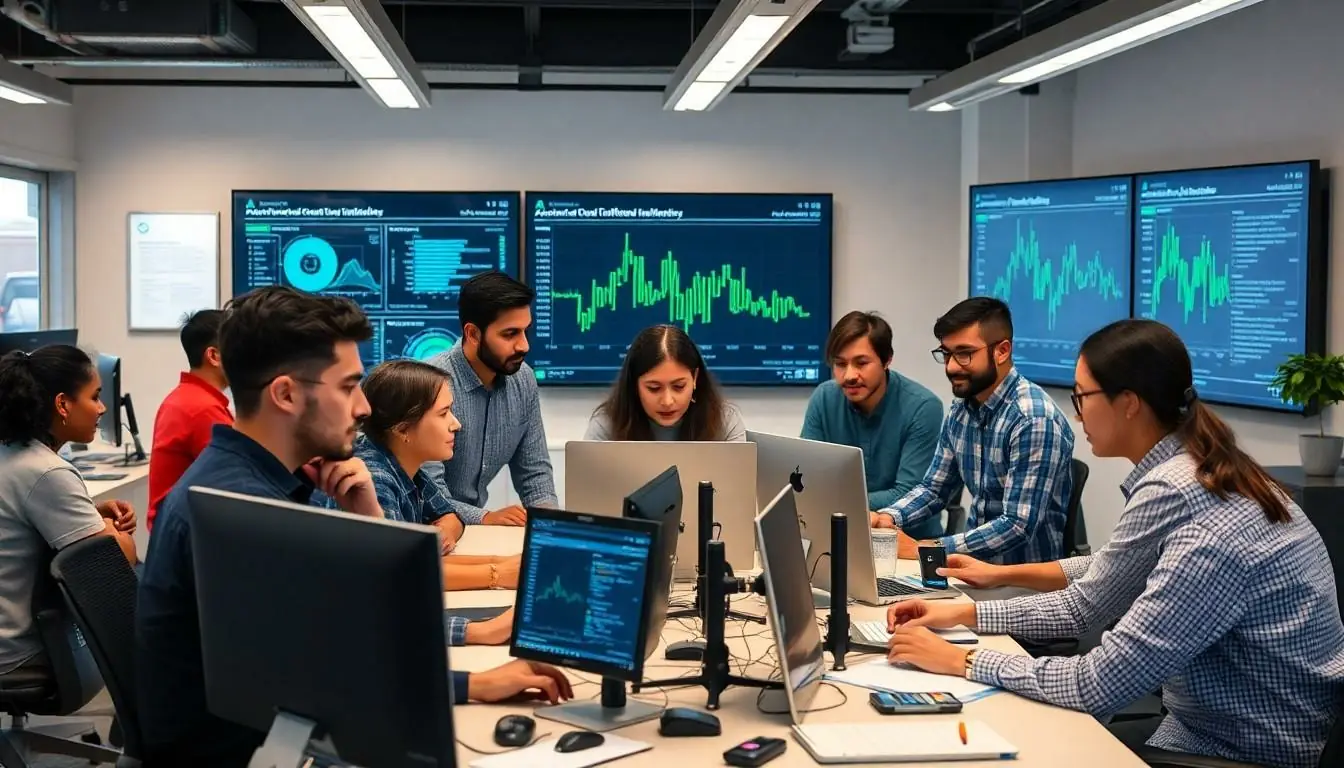Curious about who’s behind the curtain of ChatGPT? You’re not alone! This AI marvel isn’t just a brainy chatbot; it’s the brainchild of some seriously smart folks at OpenAI. They’ve spent countless hours training it to understand and generate human-like text. But don’t worry, they didn’t use magic or a crystal ball—just cutting-edge technology and a whole lot of data.
Imagine a team of researchers and engineers huddled together, fueled by coffee and creativity, crafting a digital conversationalist that can chat about anything from the weather to quantum physics. It’s like having a super-smart friend who never sleeps and always has the perfect comeback! So, buckle up as we dive into the fascinating world of ChatGPT and meet the geniuses who made it all possible.
Table of Contents
ToggleWho Is ChatGPT Made By
ChatGPT is developed by OpenAI, an organization founded in December 2015 focused on artificial intelligence research. Engineers and researchers at OpenAI work collaboratively to create advanced AI systems like ChatGPT that can understand and generate human-like text. The team employs deep learning techniques, emphasizing the importance of large datasets in training the model.
OpenAI’s goal centers around ensuring that AI benefits all of humanity. They actively promote safe and beneficial AI technologies, adhering to ethical standards while developing cutting-edge innovations. Continuous iteration occurs as developers improve ChatGPT’s capabilities through ongoing training and fine-tuning. Data from various sources contributes to making ChatGPT versatile in discussing numerous topics with users.
Researchers at OpenAI utilize reinforcement learning and techniques from conversational AI to enhance ChatGPT’s responsiveness and coherence. This process helps refine its ability to hold meaningful conversations and provide accurate information. The organization’s commitment to transparency ensures that users understand the model’s capabilities and limitations.
OpenAI’s team comprises experts from diverse fields, including machine learning, natural language processing, and ethics. Their combined expertise fosters the creation of a conversational agent that adapts and evolves over time. Investment in research and development underscores OpenAI’s dedication to making conversational AI tools accessible while redefining user interaction with technology.
The History of ChatGPT Development

ChatGPT’s development reflects a diverse and collaborative effort nurtured by OpenAI. The journey began with a clear vision to create an advanced conversational AI.
Founders and Key Contributors
OpenAI, founded in December 2015, features a group of innovators leading the charge in AI research. Sam Altman, Greg Brockman, Ilya Sutskever, Wojciech Zaremba, and John Schulman represent pivotal figures in this initiative. Each contributor adds unique expertise, enriching the model’s development with insights from various disciplines. The team consists of engineers, researchers, and ethicists, all committed to advancing AI while addressing safety concerns. Their combined efforts foster a culture of collaboration, driving the evolution of ChatGPT.
Initial Goals and Objectives
When ChatGPT was introduced, the primary goal centered on creating a conversational AI that engages users effectively. Initial objectives included enhancing natural language understanding and generating human-like text. Researchers aimed for a model that could assist with everyday tasks, provide information, and facilitate engaging dialogue. Ethical considerations formed a core component of the development process, ensuring that the technology would benefit all users without compromising safety. Ongoing refinement of these objectives guided the team’s efforts, emphasizing user experience and adaptability in conversations.
The Technology Behind ChatGPT
ChatGPT employs sophisticated technology to deliver engaging conversational experiences. This innovative system relies heavily on the principles of natural language processing (NLP) and machine learning.
Natural Language Processing
Natural language processing serves as the backbone of ChatGPT’s functionality. By utilizing advanced algorithms, it enables the model to comprehend and generate human-like text. Understanding context and nuance in conversations comes from extensive training on diverse language data. Each interaction enhances its ability to engage in meaningful dialogues. Techniques like tokenization and sentiment analysis further improve the model’s comprehension. This understanding allows ChatGPT to respond accurately and contextually, making conversations feel more natural.
Machine Learning Frameworks
Machine learning frameworks form a crucial part of ChatGPT’s architecture. These frameworks facilitate the development and training of the model using large datasets. Emphasis on deep learning techniques enables the AI to recognize patterns in language and improve over time. Comprehensive training iterations refine its performance, ensuring adaptability across various topics. Libraries such as TensorFlow and PyTorch support these processes, providing robust environments for model training. Regular updates and fine-tuning maintain its accuracy and relevance while addressing user needs.
The Role of OpenAI
OpenAI plays a crucial role in developing ChatGPT, focusing on advancing artificial intelligence for the greater good. The organization’s blend of skilled researchers and engineers creates innovative AI technologies capable of revolutionizing human communication.
Organization Overview
OpenAI, founded in December 2015, emphasizes research in artificial intelligence. The organization brings together experts from machine learning, natural language processing, and ethics. Collaboration among these specialists fosters a rich environment for developing cutting-edge technologies. With a commitment to transparency and safety, OpenAI actively shares research findings and development updates with the public. Users benefit from this openness, as it builds trust in the AI tools developed, including ChatGPT.
Mission and Vision
OpenAI aims to ensure that artificial intelligence benefits humanity as a whole. The organization envisions creating safe and beneficial technologies that improve everyday life. Responsible AI development drives their mission, prioritizing ethical considerations in all projects. Users experience improved interactions due to ongoing research into natural language understanding. OpenAI’s vision extends to making advanced conversational AI accessible, transforming the way individuals engage with technology. By focusing on collaboration and continuous improvement, OpenAI commits to a future where AI enhances human capabilities.
Impact and Applications of ChatGPT
ChatGPT influences various sectors with its adaptability and advanced language processing. It assists businesses in customer service by providing quick, automated responses to inquiries. Educational institutions utilize ChatGPT as a teaching assistant, delivering explanations and supporting student engagement. Researchers apply the model to analyze large text datasets, uncovering insights through natural language processing.
The healthcare industry leverages ChatGPT to enhance patient communication and triage support. By serving as a preliminary contact point, it helps streamline patient experiences. Enterprises also see value in using the AI for generating content, where it can draft articles and marketing materials efficiently.
Moreover, game developers integrate ChatGPT into gaming experiences. Players engage with AI-driven characters, creating immersive narratives that adapt to player choices. Organizations benefit from custom applications that employ ChatGPT to facilitate brainstorming sessions, harnessing its ability to generate creative ideas on demand.
The significance of ethical considerations cannot be overstated. Developers prioritize safety and user trust by implementing rigorous testing and guidelines throughout applications. Continuous monitoring ensures that ChatGPT’s use aligns with ethical standards in various environments.
Overall, the range of applications demonstrates how ChatGPT reshapes interaction across industries. As businesses and institutions innovate, they embrace ChatGPT’s potential, enhancing productivity and engagement while remaining mindful of its responsible use. The ongoing development showcases a commitment to improving capabilities, confirming ChatGPT’s role in future conversational AI advancements.
ChatGPT represents a significant achievement in the realm of artificial intelligence. Developed by OpenAI’s dedicated team it showcases the power of collaboration among experts in various fields. Their commitment to ethical practices and user safety ensures that this conversational AI tool is not only advanced but also responsible.
As ChatGPT continues to evolve through ongoing research and refinement it stands poised to transform how individuals and businesses interact with technology. Its diverse applications across sectors highlight its versatility and potential to enhance productivity. OpenAI’s vision for a future where AI benefits humanity is evident in every aspect of ChatGPT’s development and deployment.







